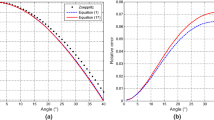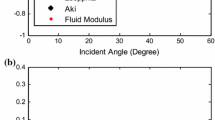Abstract
Existing seismic prediction methods struggle to effectively discriminate between fluids in tight gas reservoirs, such as those in the Sulige gas field in the Ordos Basin, where porosity and permeability are extremely low and the relationship between gas and water is complicated. In this paper, we have proposed a comprehensive seismic fluid identification method that combines ray-path elastic impedance (REI) inversion with fluid substitution for tight reservoirs. This approach is grounded in geophysical theory, forward modeling, and real data applications. We used geophysics experiments in tight gas reservoirs to determine that Brie’s model is better suited to calculate the elastic parameters of mixed fluids than the conventional Wood’s model. This yielded a more reasonable and accurate fluid substitution model for tight gas reservoirs. We developed a forward model and carried out inversion of REI, which reduced the non-uniqueness problem that has plagued elastic impedance inversion in the angle domain. Our well logging forward model in the ray-path domain with different fluid saturations based on a fluid substitution model proved that REI identifies fluids more accurately when the ray parameters are large. The distribution of gas saturation can be distinguished from the crossplot of REI (p= 0.10) and porosity. The inverted ray-path elastic impedance profile was further used to predict the porosity and gas saturation profile. Our new method achieved good results in the application of 2D seismic data in the western Sulige gas field.
Similar content being viewed by others
References
Brie, A., Pampuri, F., Marsala, A. F., et al., 1995, Shear sonic interpretation in gas bearing sands: 70th SPE Annual Technical Conference and Exhibition, Society of Petroleum Engineers, Dallas, Texas, U. S. A.
Connolly, P., 1999, Elastic impedance: The Leading Edge, 18(4), 438–452.
Close, D., Stirling, S., Horn, F., et al., 2010. Tight gas geophysics: AVO inversion for reservoir characterization: CSEG Recorder, 35(5), 28–35.
Domenico, S. N., 1977, Elastic properties of unconsolidated porous sand reservoirs: Geophysics, 42(7), 1339–1368.
Dou, Y. T., Wang, D. X., Zhao, Y. H., et al., 2014, Application of tight gas prestack key techniques in LD area: Progress in Geophysics (in Chinese), 29(4), 1644–1649.
Gassmann, F., 1951, Über die elastizität poröser medien: Vierteljahrss-chrift der Naturforschenden Gesellschaft in Zurich, 96, 1–23.
Gong, X. P., Zhang, F., Li, X. Y., et al., 2013, Study of S-wave ray elastic impedance for identifying lithology and fluid: Applied Geophysics, 10(2), 145–156.
Goodway, B., Perez, M., Varsek, A., J., et al., 2010, Seismic petrophysics and isotropic-anisotropic AVO methods for unconventional gas exploration: The Leading Edge, 29(12), 1500–1508.
Hafez, A., and Castagna, J. P., 2016, Distinguishing gas-bearing sandstone reservoirs within mixed siliciclastic-carbonate sequences using extended elastic impedance: Nile Delta\3-Egypt: Interpretation, 4(4), T427–T441.
Han, D. H., and Batzle, M. L., 2004, Gassmann’s equation and fluid saturation effects on seismic velocities: Geophysics, 69(2), 398–405.
Kato, A., Akihisa, K., Knapp, L., et al., 2017, Sweet spot mapping in the Montney tight gas reservoir: SPE Abu Dhabi International Petroleum Exhibition & Conference, Abu Dhabi, UAE.
Li, C., Yin, X. Y., Zhang, G. Z., et al., 2014, Two-term elastic impedance inversion based on the incidentangle approximation: Chinese Journal of Geophysics, (in Chinese), 57(10), 3442–3452.
Li, L., Ma, J. F., Wang, H. F., et al., 2017, Study of shear wave velocity prediction during CO2-EOR and sequestration in Gao 89 area of Shengli Oilfield: Applied Geophysics, 14(3), 372–380.
Lindseth, R. O., 1978, Synthetic sonic Logs-A process for strtigraphic interpretation: Geophysics, 44(1), 3–26.
Ma, J. F., 2003, Forward modeling and inversion method of the generalized elastic impedance in seismic exploration: Chinese Journal of Geophysics, 46(1), 118–124.
Ma, J. F., and Morozov, I. B., 2004, Ray-path elastic impedance: 2004 Canadian Society of Exploration Geophysicists National Convention, AVO. Calgary, Canada.
Ma, Z. G., Zhang, J. Q., Cai, Y. H., et al., 2012, Study on gas identification factor of tight sandstone reservoirs in Lower Shihezi formation from Daniudi Gasfield, Ordos Basin: Geophysical Prospecting for Petroleum (in Chinese), 51(4), 414–419.
Miller, M., and Shanley, K., 2010, Petrophysics in tight gas reservoirs-key challenges still remain: The Leading Edge, 26(12), 1465–1469.
Qiang, M., Miao, Q. M., Zhu, W. M., et al., 2015, Method of quantitative of seismic elastic multiparameter cross plot on effective prediction in SG gas field: Process in Geophysics (in Chinese), 30(1), 0293–0299.
Santos, L. T., and Tygel, M., 2004, Impedancetype approximations of the P-P elastic reflection coefficients: Modeling and AVO inversion: Geophysics, 69(2), 592–598.
Shi, L., Liu, J. Z., Dong, N., et al., 2015, Extended elastic impedance inversion technology and its application to the tight and thin sandstone reservoir: Geophysical and Geochemical Exploration (in Chinese), 39(2), 346–351.
Shuey, R. T., 1985, A simplification of the Zoeppritz equation: Geophysics, 50(4), 609–634.
Smith, T. M., Sondergeld, C. H., and Rai, C. S., 2003, Gassmann fluid substitutions: A tutorial: Geophysics, 68(2), 430–440.
Wang, D. X., 2016, Study on the rock physics model of gas reservoirs in tight sandstone: Chinese Journal of Geophysics (in Chinese), 59(12), 4603–4622.
Wang, D. X., Zhang, M. B., Chen, J., et al., 2014, Application of multi-wave seismic in tight sandstone gas reservoir exploration: Oil Geophysical Prospecting, (in Chinese) 49(5), 0946–0953.
Wang, H. F., 2017, Study of discriminating fluids in tight gas reservoir by using seismic ray-path elastic impedance: M.Sc. Thesis, Northwest University.
Wang, Y. H., 2003, Seismic amplitude inversion in reflection tomography: Elsevier, Amsterdam.
Wei, X. C., Liu, T., Chen, T. S., et al., 2012, AVO inversion method of ray parameter: Oil and Gas Forum of China, 2012-Geopgysical Prospecting Technology Symposium, 30–38.
Whitcombe, D. N., 2002, Elastic impedance normalization: Geophysics, 67(1), 60–62.
Wood, A. B., 1955, A textbook of sound: New York: The MacMillan Co, 360.
Zhao, H. T., Wang, H. C., Liu, J., et al., 2014, Reasons of low yield of tight sandstone gas of He8 member in eastern Ordos Basin: Lithologic Reservoirs, (in Chinese) 26(5), 75–79, 90.
Zhang, F., Wang, Y., and Li, X. Y., 2012, Viabilities of seismic ray impedance and elastic impedance for hydrocarbon-sand discrimination: Geophysics, 77(4), M39–M52.
Zhang F, and Wang Y., 1994, Ray impedance on the Tight-sand Gas Reservoir: Folia Primatologica: International Journal of Primatology, 62(1–3), 74–92.
Acknowledgements
The authors thank the National & Local Joint Engineering Research Center of Carbon Capture and Storage Technology of Northwest University for providing support, and we thank the editors and anonymous reviewers for their patient and meticulous revisions and suggestions.
Author information
Authors and Affiliations
Corresponding author
Additional information
This work was supported by the National Science and Technology Major Project (No. 2016ZX05050 and 2017ZX05069), and CNPC Major Technology Special Project (No. 2016E-0503).
Wang Da-Xing, Ph.D., he received the B.S. and M.S. degrees in geophysical exploration from the Southwest Petroleum University, Sichuan, China, in 1983 and 1995, respectively, and the Ph.D. degree in solid geophysics from the Institute of Geology and Geophysics, Chinese Academy of Sciences, Beijing, China, in 2005. He is currently a Professor-level Senior Engineer with the Exploration and Development Research Institute of PetroChina Changqing Oilfield Company, Xi’an, China. His research interests include reservoir prediction and hydrocarbon detection.
Wang Hao-Fan, she earned the B.S. and M.S. degrees in geodetection and information technology from Department of Geology, Northwest University in 2014 and 2017. She is currently an experimental technician in Department of Geology of Northwest University. Her research interests are seismic forward and inversion, and CO2 geological storage.
Rights and permissions
About this article
Cite this article
Wang, DX., Wang, HF., Ma, JF. et al. Fluids discrimination by ray-path elastic impedance inversion: A successful case from Sulige tight gas field. Appl. Geophys. 16, 218–232 (2019). https://doi.org/10.1007/s11770-019-0758-1
Received:
Revised:
Published:
Issue Date:
DOI: https://doi.org/10.1007/s11770-019-0758-1




